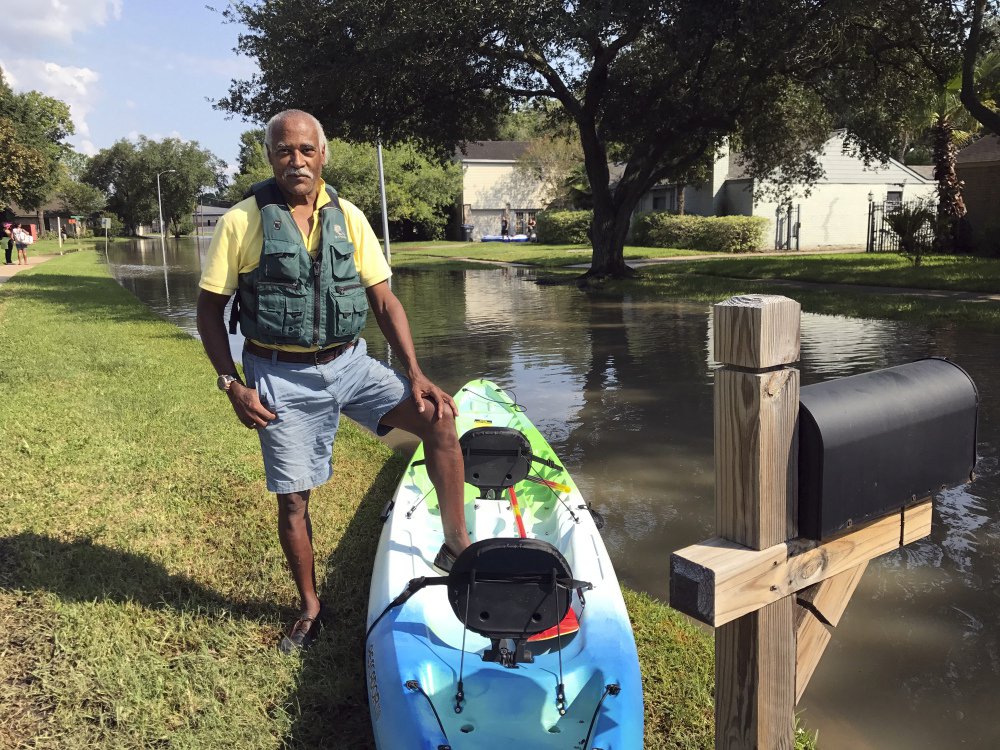HOUSTON — The explosive expansion of Houston subdivisions into prairies far to the west helped make the city affordable for the average 345 people who moved there each day, but it also paved over thousands of acres that the U.S. Army Corps of Engineers had intended for a reservoir and other flood-control projects to help against deluges like the ones from Harvey.
The push of subdivisions and freeways across what once was hundreds of square miles of flood-absorbing tallgrass prairies was part of the U.S.-leading population growth of Houston and surrounding Harris County. But the go-go-growth placed housing developments across the drainage basin of the two major reservoirs and dams safeguarding downtown Houston.
Thousands living in the western subdivisions that crowd up to the edges of the reservoirs remain under evacuation orders, after Harvey’s record rains killed dozens of people in the Houston area and beyond, flooded tens of thousands of homes, and sent floodwater roaring around the edge of Houston’s Addicks Dam for the first time in its 70-year history.
“Guess what was out here” when Houston’s dams were built, said Gordon Prendergast, who had bought a kayak to come see how his house was faring after his neighborhood was evacuated. “Wilderness! Goats and wild coyotes, and nobody had any idea they’d build houses out here when the Army Corps was building that dam.”
Prendergast, 65, didn’t blame the Corps or the engineers for the flooding of all the houses crowded around reservoirs. “The only thing they could have done differently is block off this entire area, and make this a national park, and say you cannot have subdivisions,” he said.
“They probably would have been fighting developers and lawyers for 20 to 30 years.”
Addicks and Barker dams and reservoirs west of downtown anchor the flood protection system of the fourth-largest U.S. city.
PREPARATION PREEMPTED
The Corps bought land for the two projects and built them in the 1940s after floods inundated downtown.
The Corps’ plan at the time also called for a third reservoir in northwest Houston, as well as a levee and two grand canals intended to funnel water around the city and out to the Gulf of Mexico, then-local Corps commander Col. Richard Pannell told a Houston town meeting over flooding last year.
But authorities never put together the money to buy land for the additional flood control. Development quickly made the tracts too expensive to buy for the projects.
Development to the west of downtown has brought the area desirable employers such as Amazon and FedEx, and subdivisions that made Houston affordable for the average person in a way that San Francisco or New York are not, said Augustus Campbell of the development-friendly West Houston Association nonprofit.
“One of the reasons Houston has been economically successful is you don’t have to be rich if you’re in Houston,” Campbell said.
DEVELOPMENT STRAINS DAMS
But each ring of development – covering absorbent grassland and wetlands with concrete – makes for heavier, faster deluges of water rushing on the developments downstream, and further strains the two dams and reservoirs, Pannell said in that talk last year. A Corps spokesman did not return a message for comment this week, amid the record flooding.
“Houston is not known for its planning,” notes Evelyn Merz of the local Sierra Club. The environmental group went to court five years ago and tried unsuccessfully to block a new parkway on the Katy Prairie to the west of Houston, saying the parkway would draw yet more development and more flooding Houston wasn’t prepared to handle.
Houston’s push west has consumed all but the last 200,000 acres of the Katy Prairie, said Mary Anne Piacentini, executive director of the Katy Prairie Conservancy, whose work includes managing 20,000 acres of prairie preserve.
With roots stretching well over a dozen feet beneath the soil, native tallgrass can absorb nearly 20 times more water than lawns can, reducing and slowing the cascades of water running off Houston’s concrete, Piacentini said. She has worked, with mixed results, to encourage Houston’s managers and politically influential developers to promote more prairie open space and so-called pocket prairies within the city.
Houston’s long-term planning projects the sprawl across the Katy Prairie will persist, eventually reaching the Brazos River.
Jim Blackburn, lawyer for the Sierra Club in the fight against the parkway and a planning professor at Rice University, hopes to see a revised development scheme given the lessons of Harvey: A Houston with more reservoirs, with protected grasslands and ranches on the city’s outskirts, and greenbelts throughout the city.
With the flood, “Houston is at a real crossroads,” Blackburn said. “How we respond to this tragedy will determine … how viable and vibrant Houston will be.”
Send questions/comments to the editors.



Success. Please wait for the page to reload. If the page does not reload within 5 seconds, please refresh the page.
Enter your email and password to access comments.
Hi, to comment on stories you must . This profile is in addition to your subscription and website login.
Already have a commenting profile? .
Invalid username/password.
Please check your email to confirm and complete your registration.
Only subscribers are eligible to post comments. Please subscribe or login first for digital access. Here’s why.
Use the form below to reset your password. When you've submitted your account email, we will send an email with a reset code.